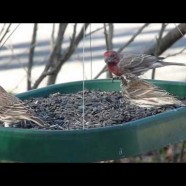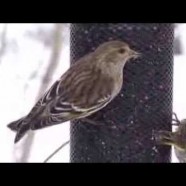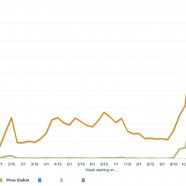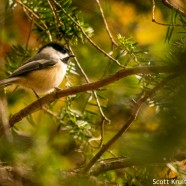Purple Finch vs House Finch comparison with feeder birds
Here we have a female Purple Finch (Haemorhous purpureus) feeding throughout the video along with a female House Finch (Haemorhous mexicanus) and a male House Finch later on. A Tufted Titmouse (Baeolophus bicolor) and Black-capped Chickadee (Poecile atricapillus) also make an appearance among the common feeder birds visiting this tray of sunflower seeds. Note that the female Purple Finch is larger and bulkier than her House Finch counterpart. She has more boldly defined colors in all regards with additional heavier and stronger facial and head markings. Take a few watches to get a feel for...
Read MorePine Siskins extremely close feeding in snow
This group of Pine Siskins (Spinus pinus) was filmed extremely close up in HD as they hungrily fed on thistle seed during an unusually cold and snowy day. A few American Goldfinch (Spinus tristis) were mixed in the flock. Both species can be heard softly calling while chowing down.
Read MoreRufous Hummingbird and vagrancy
This past weekend I was able to briefly visit and photograph a vagrant hummingbird from the west at an undisclosed location in Connecticut. I was told of the sighting by two experts who had documented the bird a couple hours earlier, confirming via observations and photos that this was a Rufous Hummingbird (Selasphorus rufus), and not the very easy to confuse Allen’s Hummingbird (Selasphorus sasin) which would have been even more rare. The bird pictured below is an immature female. She paused only briefly in the tree being otherwise occupied and somewhat anxious, zipping back and...
Read MorePurple Finch and Pine Siskin invasion
Two species have recently flooded the Northeast and Mid-Atlantic according to list serv reports, accounts from friends and my own personal observations – the Purple Finch and the Pine Siskin. The former has been unbelievably abundant in my experience, often being difficult to go outside for any length of time without seeing one in the past month. The latter, while a bit tougher to spot, has nonetheless zipped by in sizable groups and maintained their nomadic feeding habits. Just how massive are these irruptions in our region? I turned to eBird to find out the truth. Here are both...
Read MoreBlack-capped Chickadee (Poecile atricapillus) irruption
There have been Black-capped Chickadees (Poecile atricapillus) moving south in very subtle ways for a couple of months now. If you watch migratory hotspots you can sometimes detect their irruption years, especially if that location is not a particularly friendly habitat for the species. I have seen flocks of 10-20 birds tightly packed together and feeding on the move, possibly heading for a feeding station like yours. I always wonder what particular triggers end up notifying a widespread and highly adaptive bird like this one that they should nonetheless change their quarters for the autumn...
Read More








